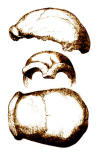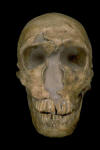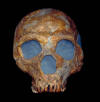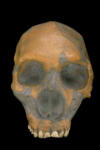All About Neanderthal
Fossils
As stated previously, the first
Neanderthal skulls were discovered in Engis, Belgium, in 1829 and Forbes'
Quarry, Gibraltar, in 1848 prior to the "original" discovery in a limestone
quarry of the Neander Valley (near Düsseldorf) in August, 1856, three years
before Charles Darwin's On the Origin of Species was published. The
type specimen,
dubbed Neanderthal 1 (skull cap at right) consisted of a skull cap, two
femora, three bones from the right arm, two from the left arm, part of the
left ilium, fragments of a scapula, and ribs. (An image of the skull cap can
be
seen here.)
Origin of Species was published. The
type specimen,
dubbed Neanderthal 1 (skull cap at right) consisted of a skull cap, two
femora, three bones from the right arm, two from the left arm, part of the
left ilium, fragments of a scapula, and ribs. (An image of the skull cap can
be
seen here.)
There are several notable Neanderthal fossils, listed below.
La Ferrassie 1
La Ferrassie 1 is a fossilized skull of a male homo
 neanderthalensis. It was discovered in La Ferrassie, France by R.
Capitan in 1909. It is estimated to be about 70,000 years old. (Image
at right, from the Smithsonian.1 Its characteristics include a
large occipital bun, low-vaulted cranium, a large nasal opening, and heavily
worn teeth. AAn asymmetry in the wear across the incisors was noticed
during its study. Instead of wearing flat, the biting surface is
beveled toward the front. Some have hypothesized that this is the
result of habitually holding something in his mouth.
neanderthalensis. It was discovered in La Ferrassie, France by R.
Capitan in 1909. It is estimated to be about 70,000 years old. (Image
at right, from the Smithsonian.1 Its characteristics include a
large occipital bun, low-vaulted cranium, a large nasal opening, and heavily
worn teeth. AAn asymmetry in the wear across the incisors was noticed
during its study. Instead of wearing flat, the biting surface is
beveled toward the front. Some have hypothesized that this is the
result of habitually holding something in his mouth.
The La Ferrassie site has yielded skeletons from eight individuals, including adults, children, infants, and two fetuses.
Shanidar 1
Shanidar is a cave site located in the foothills of the Zagros Mountains in north-eastern Iraq. It was excavated between 1957 and 1961 by a team from Columbia University. There was a total of nine skeletons, labeled Shanadar 1 through 9. All that remains of the find is kept at the Smithsonian. It consists of one skeleton, and casts of the others. The remaining skeletons are presumed to have been dispersed in Iraq. \
Shanidar 1 was an elderly male, between 40-50 years of age (skull at right
1). The skeleton showed signs of severe deformity, some thought to be
trauma-related. At some point he suffered a blow to the left side of
his face. He also had a withered right arm, which had been fractured
and healed in several places. This arm may have caused some paralysis
on his right side, leading to the deformities in his lower legs and foot,
which indicate he would have walked with a limp.
skeleton showed signs of severe deformity, some thought to be
trauma-related. At some point he suffered a blow to the left side of
his face. He also had a withered right arm, which had been fractured
and healed in several places. This arm may have caused some paralysis
on his right side, leading to the deformities in his lower legs and foot,
which indicate he would have walked with a limp.
Shanidar 2
Shanidar 2 (skull image) was an adult male, who evidently died in a rock fall inside the cave, as his skull and bones were crushed. Some have suggested that there is evidence that Shanidar 2 was given a ritual send-off: a small pile of stones with some worked stone points (made out of chert) were found on top of his grave. Also, there had been a large fire by the grave, with a concentration of split and broken animal bones nearby, suggesting a funeral ceremony involving consumption of food had been held. There was also evidence of alcohol use, as seeds belonging to the psfraisis plant, used in pits and fermented to produce a primitive alcoholic drink, were found in abundance lying next to the burial site. Of course, all these evidences could merely be coincidences, indicating that life continued on, despite the fact there was a gravesite nearby.
Shanidar 3
Shanidar 3, another adult male, also died in a rock fall in the cave. He was buried in the same grave as Shanidar 1 and 2. Shanidar III also suffered from a degenerative joint disorder (DJD) in his foot, which would have resulted in painful, limited movement.
Shanidar 4
Of all the skeletons found at the Shanidar cave, it is Shanidar IV which provides the best evidence for Neanderthal burial ritual. The skeleton of an adult male aged between 30-45 years was discovered in 1960 by Ralph Solecki and was positioned so that he was lying on his left side in a partial fetal position. Routine soil samples which were gathered for pollen analysis in an attempt to reconstruct the palaeoclimate and vegetational history of the site from around the body were analysed eight years after its discovery. In two of the soil samples in particular, whole clumps of pollen were discovered in addition to the usual pollen found throughout the site and suggested that entire flowering plants (or at least heads of plants) had entered the grave deposit. Furthermore, a study of the particular flower types suggested that the flowers may have been chosen for their specific medicinal properties. Yarrow, Cornflower, Bachelor’s Button, St. Barnaby’s Thistle, Ragwort or Groundsel, Grape Hyacinth, Joint Pine or Woody Horsetail and Hollyhock were represented in the pollen samples, all of which have long-known curative powers as diuretics, stimulants, astringents as well as anti-inflammatory properties. This led to the idea that the man could possibly have had shamanic powers, perhaps acting as medicine man to the Shanidar Neanderthals. However, recent work into the flower burial has suggested that perhaps the pollen was introduced to the burial by animal action as several burrows of a gerbil-like rodent known as a Persian jird were found nearby. The jird is known to store large numbers of seeds and flowers at certain points in their burrows and this argument was used in conjunction with the lack of ritual treatment of the rest of the skeletons in the cave to suggest that the Shanidar IV burial had natural, not cultural origins.
La Chapelle-aux Saints 1
La Chapelle-aux Saints 1 (AKA The Old Man) is a fossilized skull (image
 at right1) of the species Homo neanderthalensis. It was
discovered in La Chapelle-aux-Saints, France by A. and J. Bouyssonie in
1908. Its characteristics include the low vaulted cranium and large
browridge typical of Neaderthals. It is estimated to be about 60,000
years old. He was at least 40 years old with a somewhat hunched over
posture resulting from severe arthritis in his spine. There was a bowing of
his legs that may have resulted from rickets disease in childhood. He had
lost most of his teeth and part of his jaw resulting in a disharmonic
looking face.
The skull has two teeth, one upper and one lower
premolar, which articulate perfectly.
at right1) of the species Homo neanderthalensis. It was
discovered in La Chapelle-aux-Saints, France by A. and J. Bouyssonie in
1908. Its characteristics include the low vaulted cranium and large
browridge typical of Neaderthals. It is estimated to be about 60,000
years old. He was at least 40 years old with a somewhat hunched over
posture resulting from severe arthritis in his spine. There was a bowing of
his legs that may have resulted from rickets disease in childhood. He had
lost most of his teeth and part of his jaw resulting in a disharmonic
looking face.
The skull has two teeth, one upper and one lower
premolar, which articulate perfectly.
Le Moustier
Le Moustier is an archeological site consisting of two rock shelters
 inPeyzac-le-Moustier, Dordogne, France. It is known for a fossilized skull
of the species Homo neanderthalensis that was discovered in 1909 (image at
right1) The
Mousterian tool culture is named after Le Moustier. The Le Moustier
skull is estimated to be less than 45,000 years old. Its characteristics
include a large nasal cavity and a somewhat less developed brow ridge and
occipital bun as might be expected in a juvenile.
inPeyzac-le-Moustier, Dordogne, France. It is known for a fossilized skull
of the species Homo neanderthalensis that was discovered in 1909 (image at
right1) The
Mousterian tool culture is named after Le Moustier. The Le Moustier
skull is estimated to be less than 45,000 years old. Its characteristics
include a large nasal cavity and a somewhat less developed brow ridge and
occipital bun as might be expected in a juvenile.
Other Fossils
To date, over 400 specimens of Neanderthal have been discovered. To view pictures of several other fossils, click here.
1 Smithsonian image from the website of the Smithsonian Institution. It and may be copyrighted. The Smithsonian Institution explicitly considers use of its content for non-commercial educational purposes to qualify as fair use under United States copyright law.
If you are not a Christian, and you have been holding out on making a decision for Christ because the Church always preached a message that was contrary to what you saw in the scientific world, then rest assured that the Bible is the inerrant Word of God, and you can believe in Christ and receive salvation, while still believing in an old earth. Click here for more.
Are you a Christian who believes in young earth creationism? Now that we have shown the many difficulties of the young earth creation science model in this and many other articles, how does this impact your Christian life? If you are a young earth creationism believer, click here.
All About Neanderthal
Fossils
To learn more
about old earth creationism, see
Old Earth Belief,
or check out the article
Can You Be A
Christian and Believe in an Old Earth?
Feel free to check out more of this website. Our goal is to
provide rebuttals to the bad science behind young earth creationism,
and honor God by properly presenting His creation.
